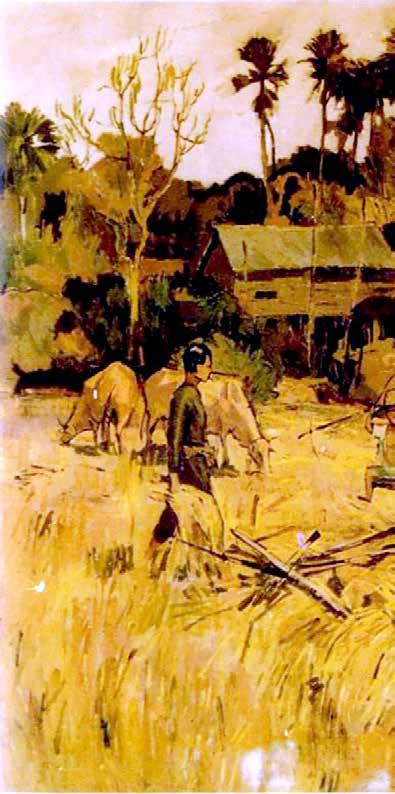
5 minute read
Mohamed Zakaria Soltan
Poster Poser: Mohamed Zakaria Soltan
Mohamed Zakaria Soltan has mentioned that “…many of his digital creations draw inspiration from the tales and symbols of the ancient Pharaonic civilisation. His visual and psychological conscience is extended and fed by his culture and visual cultural legacy, which generates an internal equilibrium for the artist and the human.”
Advertisement
From hand painted posters to stone lithograph and screen printing then, onward, until the digital designs of today the poster has gone through many permutations and innovations. The Egyptian artist Dr. Mohamed Zakaria Soltan is a full-time lecturer in the advertising department of the faculty of applied arts at Egypt's October 6 University. With his intriguing work he treads the very thin line between commercial and fine art with his chosen process of digital origination which effectively cocks a snook at Walter Benjamin, his notion of ‘aura’, the notion of authenticity and the idea of the limited accessibility of an ‘original’.
Soltan, and digital design, presents the concept of a non-tangible ‘original’, that is an original item of visual ‘art’ which has no physicality before being made tangible through printing (possibly on archival 'pigment print’, 'Giclée print’ or art print). The digital artwork (poster) resembles Schrödinger’s cat, it is in existence (digitally) but also not in existence (as a tangible).
We are informed that “The Poster was one of the earliest forms of advertisement and began to develop as a medium for visual communication in the early 19th century…The poster quickly spread around the world and became a staple of the graphic design trade. Many artists as well, such as Henry Toulouse-Latrec and Henry van de Velde, created posters.”
One website from Britain’s ‘The Tate’ indicates that in the early 1980s, computer engineers “… devised a paint program which was used by the pioneering digital artist Harold Cohen” the result was ‘Untitled Computer Drawing’ (1982). (2) From 1990 (the year the first web browser was developed by Tim Berners Lee and the creation of a virtual world) the notion of ‘digital’ expanded and has continued to expand until the notion of a ‘digital original’ is considered.
Like his contemporaries in Egyptian art Hazem Taha Hussein and Khaled Hafez, Soltan’s graphic visualisation not only has roots back over seven thousand years to Egyptian ‘picture writing’, more commonly known as hieroglyphics (logographic, syllabic and alphabetic elements too), but also in Cairo’s brief interest in ‘Surrealism’ (the Art et Liberté group 1938 - 1945) through the poet Georges
Henein and his correspondence with Andre Breton which had led to surrealist rumblings, in Egypt, from 1937, then in more modern times with Egyptian writers such as Yūsuf Idrīs (1927 - 1991).
With his digitally rendered and complexly imagined ‘Fine-Art posters’, Mohamed Zakaria Soltan frequently touches upon the notion of Pharaohs and other symbolic representations of Cairo and Egypt’s ancient past within his graphic work. This can be especially witnessed in his astoundingly colourful and impactful series of digital production Chromogenic prints, titled ‘Digital Pharaoh’ (in an exhibition in The Museum of the Factory, Lolz, Poland, titled International Print Biennial Collection, in 2017). With the ‘Digital Pharaoh’ series of images, Soltan fully realises the power of graphic images and firmly brings his country’s visual heritage fully into the 21st century.
This continuity of Egyptian symbolic construction may be also be witnessed in Soltan’s 2015 ‘Pharaonic Digital Structure 1’ and a poster from ‘Pharaonic Perspective’ for the Brand Design Association of Korea (BDAK) in the 22nd International Invitation Exhibition - Brand & Society, in Seoul, 2020/21 and further continued with images such as 'Metaverse Digital Pharaoh’. More recently (2020), Soltan addressed the issue of the Covid 19 pandemic, with the poster ‘My Emotional Design’ (for Korea Institute of Cultural Product & Design) depicting ‘Life after Corona's disappearance’. That poster is a “philosophical view that extended in literature and arts worldwide in the era of online and metaverse” according to Soltan’s promotional material (The Creative Journey of Soltan in designing the style of fine-art Posters). With that poster the artist/ designer expresses his hopes for a post-Covid world and his wishes for humanity.
Soltan’s most recent Solo Art & Design Exhibition, also showing of his Egyptian cultural pieces, was at the VIDAK, Moorim Gallery in Seoul, Korea, during the July of 2022, showing one print "OCDI 47" (One Concept ... Deep Inspiration 47) originally created in 2018, and previously shown in Poland.
There is little doubt that the Egyptian design/ artist Mohamed Zakaria Soltan is at the forefront of the concept of his country’s digital fine art, as his many works have been in exhibitions (physical and online) around the globe. Soltan re-imagines the notion of fine art and brings it firmly into the digital age. Soltan, in his works, challenges Walter Benjamin’s notion of an original work of art, and questions the sense of ‘aura’
http://www.designishistory.com/1850/posters
https://www.tate.org.uk/art/art-terms/d/ digital-art
The Work of Art in the Age of Mechanical Reproduction, Benjamin Walter, in: Illuminations, edited by Hannah Arendt, translated by Harry Zohn, from the 1935 essay New York: Schocken Books, 1969
Ed.








https://soltanart.weebly.com/




on the island
poem and pictures by martin bradley
A digital chapbook published by The Blue Lotus Publishing


https://issuu.com/martinabradley/docs/on_the_island
on the island
(Mersea Island, Colchester, Essex, UK. Images and poem by Martin A Bradley, 2021/2)

on the island
(Mersea Island, Colchester, Essex, UK. Images and poem by Martin A Bradley, 2021/2)
Mersea Island
This is a chapbook containing a poem and some images taken on Mersea Island.
There’s a clue in the name Mersea Island. Mersea is an island. The definition of an island is land surrounded by water. Mersea Island, which lays off the Eastern Coast of another island (comprising of England, Scotland and Wales), is reached over a causeway called ‘The Strood’. At high-tide, that causeway floods, making the road impassable.
Since before Roman times Mersea has been inhabited. The author only recently came to live there due to the island's peace and natural beauty. ...It hasn't disappointed.










